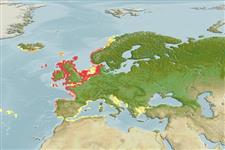Ophiuroidea |
Amphilepidida |
Amphiuridae
Environment: milieu / climate zone / ระดับความลึก / distribution range
นิเวศวิทยา
; กร่อย; ระดับความลึก 5 - 40 m (อ้างอิง 85345). Temperate
Atlantic and the Mediterranean Sea: Europe & Northern Asia (excluding China). Temperate and subtropical.
Length at first maturity / ขนาด / Weight / Age
วัยเจริญพันธุ์: Lm ? range ? - ? cm
Inhabit estuarine and inshore areas, in mud or substrates of silt to fine sand. A microvore that feeds on organic detritus as well as a carnivore-scavenger (Ref. 96352). Free-living (Ref. 3123).
Life cycle and mating behavior
วัยเจริญพันธุ์ | การสืบพันธุ์ | การวางไข่ | Eggs | ความดกของไข่ | Larvae
Members of the class Ophiuroidea are mostly gonochoric, others are protandric. Fertilization is external. Brooding is common, bursae is used as brood chambers where the embryos develop into juveniles and later crawl out from the bursal slits. Life cycle: Embryos hatch into free-swimming planktotrophic larvae and later metamorphose into tiny brittle stars which sink down the bottom where they grow into adult form.
Garmendia, J.M., J.M. Parada and J. Mora 2003 Niveles de penetración de los diferentes grupos macroinfaunales en los sedimentos arenosos sublitorales de la ría de Ares y Betanzos (Galicia) (noroeste de la península Ibérica). Bol. Inst. Esp. Oceanogr. 19 (1-4):283-291. (อ้างอิง 2795)
IUCN Red List Status
(อ้างอิง 130435: Version 2025-1)
CITES status (อ้างอิง 108899)
Not Evaluated
CMS (อ้างอิง 116361)
Not Evaluated
Threat to humans
Human uses
| FishSource |
เครื่องมือ
ข้อมูลเพิ่มเติม
Population dynamicsการเจริญเติบโตMax. ages / sizesLength-weight rel.Length-length rel.Length-frequenciesMass conversionอุดมสมบรูณ์ Life cycleการสืบพันธุ์วัยเจริญพันธุ์ความดกของไข่การวางไข่EggsEgg developmentLarvae Human RelatedStamps, coins, misc.
แหล่งที่มาจากอินเตอร์เน็ต
Estimates based on models
Preferred temperature
(Ref.
115969): 8.4 - 12.4, mean 10.3 (based on 164 cells).
Price category
Unknown.
